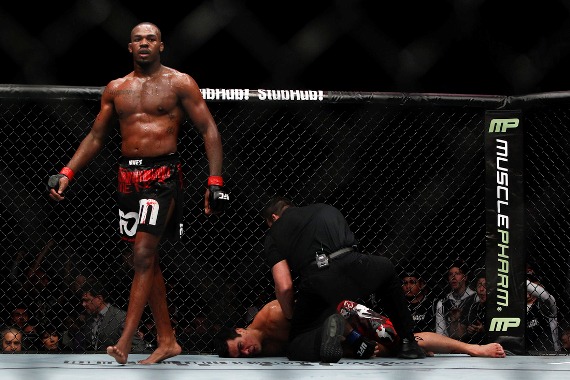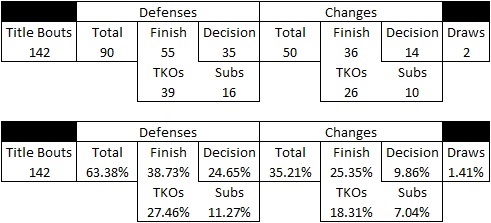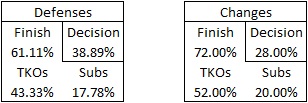 When Jon Jones stepped into the cage three and a half weeks ago to defend his UFC light heavyweight belt against Glover Teixeira, he was a sizable -440 favorite (bet $440 to win $100) at Several Bookmakers. Jones had been a significantly higher favorite in the months leading up to the bout before some late money brought the line back down just prior to the fight. As a result, it seems like a popular bet that night was Jones to win the bout inside the distance which offered a more value — it closed at -170 — and seemed like a relatively safe bet given Jones’ track record. It was a play that I made personally, and as we know it didn’t end up cashing. Jones was fairly dominant in winning a decision, but the outcome of the fight got me thinking about how title bouts play out. This weekend, bantamweight champion Renan Barao is defending his title against TJ Dillashaw, and he is an even bigger favorite than Jones was. Currently, Barao is a -800 favorite, with the comeback on Dillashaw at +550 (bet $100 to win $550). Due to the steep line, many bettors are again talking about playing the champion inside the distance in this bout, as that can be had for -135 as of this writing. Obviously Barao’s personal history suggests that he will get the finish, as all three of his title defenses have come by stoppage, but between this and the Jones fight, I decided to put some numbers together on the trends associated with UFC title bouts. Since the Unified Rules were implemented back in 2000, the UFC has put on a total of 142 title bouts in nine different weight classes. Some belts had lineages tracing back before the data even starts (Heavyweight, Light Heavyweight and Welterweight), and some are little more than a year old. Before you ask, I didn’t include WEC title bouts as they took place in a smaller cage, which could skew results. The chart below shows the outcomes of those bouts in actual numbers and by percentage.
When Jon Jones stepped into the cage three and a half weeks ago to defend his UFC light heavyweight belt against Glover Teixeira, he was a sizable -440 favorite (bet $440 to win $100) at Several Bookmakers. Jones had been a significantly higher favorite in the months leading up to the bout before some late money brought the line back down just prior to the fight. As a result, it seems like a popular bet that night was Jones to win the bout inside the distance which offered a more value — it closed at -170 — and seemed like a relatively safe bet given Jones’ track record. It was a play that I made personally, and as we know it didn’t end up cashing. Jones was fairly dominant in winning a decision, but the outcome of the fight got me thinking about how title bouts play out. This weekend, bantamweight champion Renan Barao is defending his title against TJ Dillashaw, and he is an even bigger favorite than Jones was. Currently, Barao is a -800 favorite, with the comeback on Dillashaw at +550 (bet $100 to win $550). Due to the steep line, many bettors are again talking about playing the champion inside the distance in this bout, as that can be had for -135 as of this writing. Obviously Barao’s personal history suggests that he will get the finish, as all three of his title defenses have come by stoppage, but between this and the Jones fight, I decided to put some numbers together on the trends associated with UFC title bouts. Since the Unified Rules were implemented back in 2000, the UFC has put on a total of 142 title bouts in nine different weight classes. Some belts had lineages tracing back before the data even starts (Heavyweight, Light Heavyweight and Welterweight), and some are little more than a year old. Before you ask, I didn’t include WEC title bouts as they took place in a smaller cage, which could skew results. The chart below shows the outcomes of those bouts in actual numbers and by percentage.
Of those 142 bouts, champions successfully defended their titles 90 times (63.38%), a new title holder was crowned 50 times (35.21%), and two bouts ended in draws (1.41%). The draws are not considered successful defenses for these purposes because as a bettor, a draw wouldn’t be graded as a win unless you specifically bet it. Also, one of the draws took place in a bout to crown a new champion, so the belt remained vacant in that instance. The first takeaway from this data is that underdogs are more successful in title defenses than they are overall in UFC bouts. Between 2012 and 2013, underdogs won in 31.88% of bouts, so the difference in title fights is significant. This isn’t just about finding the success rate of champions and challengers however, it’s also important to see how they win. Most title bouts never see the final bell. Out of the 142 bouts, 91 were finished (64.08%), while 51 went to decision (35.92%). This probably has something to do with the fact that title fights are five rounds, which gives the best fighters in the world more opportunities to find a finish. Interestingly, the finishing rate in title fights is about 10% higher than it has been in recent UFC history (http://fightnomics.com/blog/ufc-finishes-by-weight-class-2013/). These two stats would lead you to believe that picking and betting champions to win inside the distance is the way to go, however that’s not exactly true. In their successful title defenses, champions stop opponents 61.11% of the time (55 of 90). Challengers have stopped the bout 72% of the time when they are able to wrest the belt away from the incumbent (36 of 50). So the champions are retaining their belts more often, but finishing less often. The chart below shows the breakdown of how titles are defended and how they change hands.
In fact, of the 49 decisions in championship bouts that have had a victor – remember those two draws – champions have garnered 35 of them (71.43%). That means that when title bouts go to decision, the reigning title-holder seems to have a significant advantage with the judges. This could be a case of the old adage of having to “beat” the champion, or risking the benefit of the doubt swaying the judges in that direction. So we now know that champions are more likely to retain their belts in title fights and the majority of championship bouts end inside the distance. However, if bouts do go the distance, decisions go the way of the champion a vast majority of the time. If challengers do emerge victorious they are nearly three times as likely to do it by stoppage as opposed to by decision.  One final thing I wanted to look at was how title fights are actually finished. It has been well-documented that submissions aren’t as prevalent in the UFC today as they were in the earlier days of the sport. In fact, from 2009 through 2013, submissions accounted for just 19.89% of all fight outcomes (298 submissions in 1498 fights). Has this same trend always existed at the highest level of the sport where presumably fighters are more proficient in all aspects of MMA? In a word, yes. Only 26 title bouts have ended by submission since the unified rules came into play. That equates to just 18.31%. This begs the question (and obvious answer), where do all the finishes in title fights come from? Clearly there are a lot of TKOs when belts are on the line. 65 of them, in fact. That means 45.77% of title fights in UFC history have ended via TKO. Next time you’re thinking of placing a bet on a title fight, consider some of these numbers:
One final thing I wanted to look at was how title fights are actually finished. It has been well-documented that submissions aren’t as prevalent in the UFC today as they were in the earlier days of the sport. In fact, from 2009 through 2013, submissions accounted for just 19.89% of all fight outcomes (298 submissions in 1498 fights). Has this same trend always existed at the highest level of the sport where presumably fighters are more proficient in all aspects of MMA? In a word, yes. Only 26 title bouts have ended by submission since the unified rules came into play. That equates to just 18.31%. This begs the question (and obvious answer), where do all the finishes in title fights come from? Clearly there are a lot of TKOs when belts are on the line. 65 of them, in fact. That means 45.77% of title fights in UFC history have ended via TKO. Next time you’re thinking of placing a bet on a title fight, consider some of these numbers:
- Favorites defend their title 63.38% of the time.
- 64.08% of title fights end with a finish.
- 72% of successful title challenges are stoppages.
- Champions receive 71.43% of judges’ decisions in title bouts.
- Only 18.31% of championship fights have ended by submission.
Maybe Renan Barao notches his fourth consecutive title defense and finish against TJ Dillashaw this weekend, but the numbers suggest he’s already an aberration as far as champions go. Matt Hughes, Chuck Liddell, Anderson Silva, BJ Penn and Ronda Rousey are the only other UFC champions to successfully defend their title three times and earn those defenses by stoppage. That is among a list of the 45 different champions the promotion has had since the unified rules began governing the sport. Of those fighters, only Liddell and Silva got finishes in their fourth defense, meaning that Barao has an opportunity to join very exclusive company if he does what the odds slightly favor him to do right now, and that’s finish TJ Dillashaw on Saturday night. The numbers have said all they can. It’s time to sit back and let the fighters do the talking in the cage.

